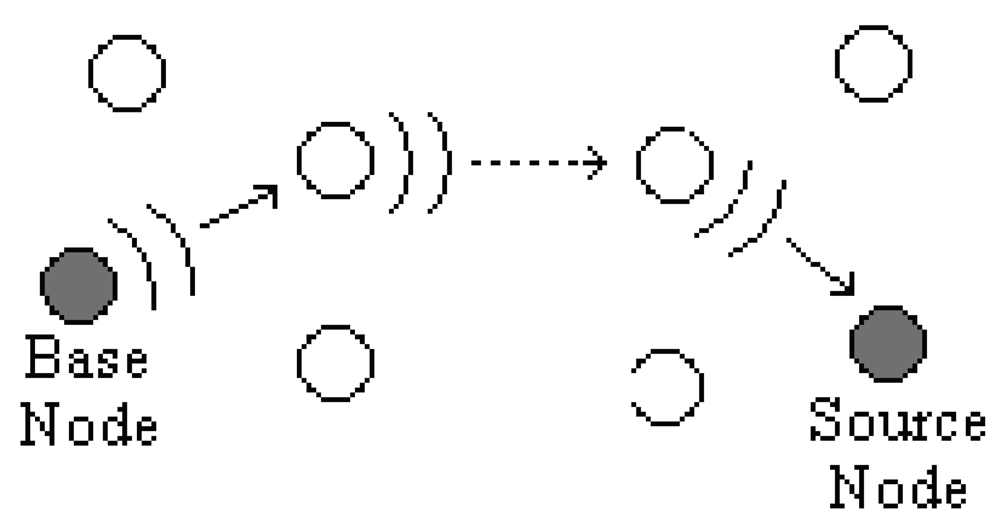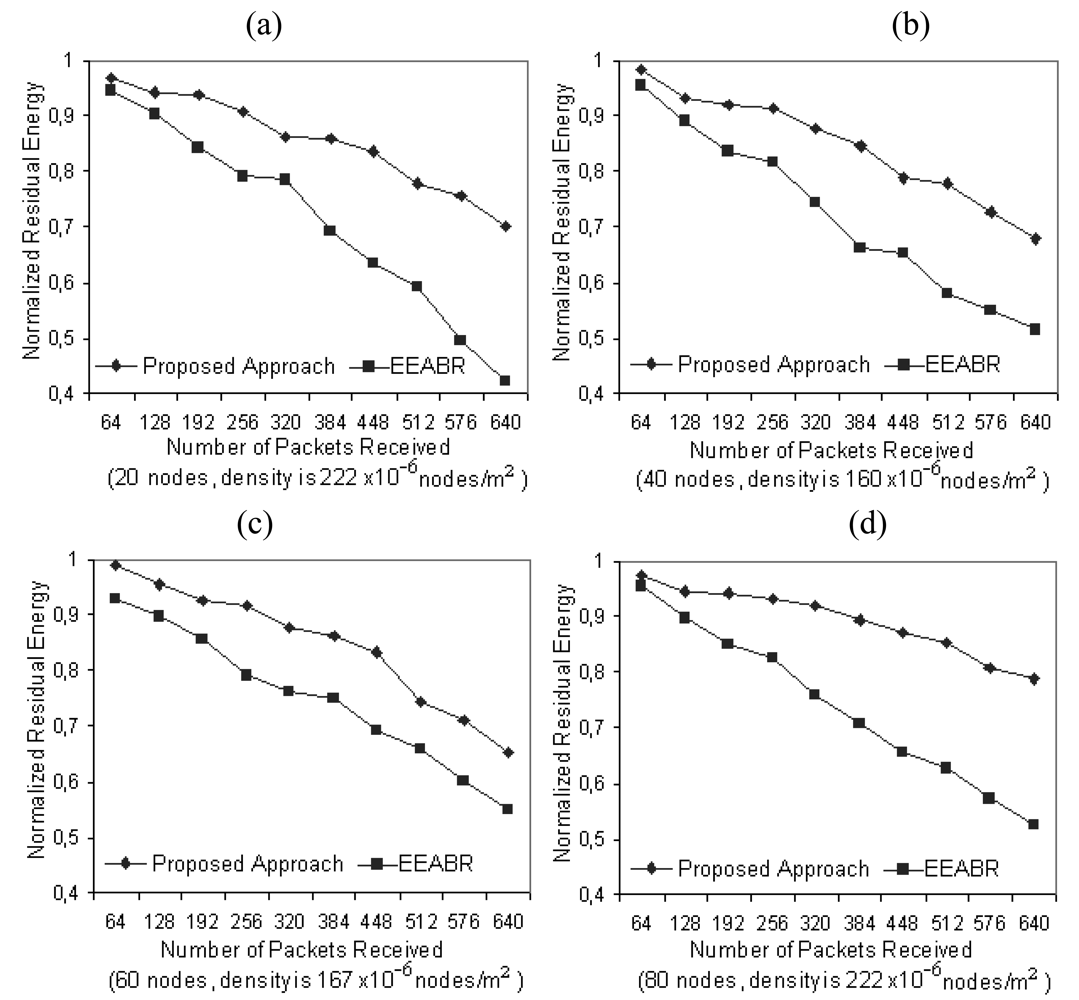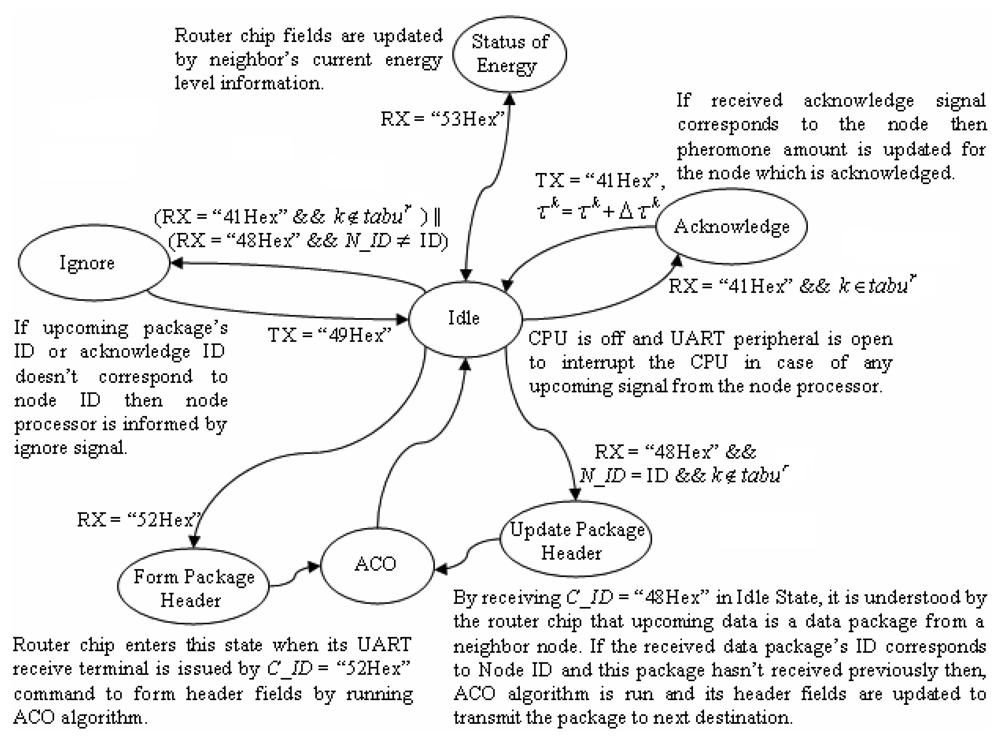Routing in Wireless Sensor Networks Using an Ant Colony Optimization (ACO) Router Chip
Abstract
:1. Introduction
2. Proposed WSN Routing Scheme
2.1. ACO Approach
2.2. Protocol Operations
2.2.1. Disseminating Data
2.2.2. Acknowledgement Method
2.2.3. Informing Energy Levels of Neighbor Nodes
3. Simulations and Results
4. Implementation of ACO Algorithm
5. Conclusions
Acknowledgments
References
- Mohammad, I.; Imad, M. Handbook of Sensor Networks; CRC Press: London, 2005; pp. 117–140. [Google Scholar]
- Kamat, P.; Zhang, Y.; Trappe, W.; Ozturk, C. Enhancing Source-Location Privacy in Sensor Network Routing. Proceedings of the 25th IEEE Int. Conference on Distributed Computing Systems (ICDCS05); 2005; pp. 599–608. [Google Scholar]
- Sun, J.-Z. Mobile Ad Hoc Networking: An Essential Technology for Pervasive Computing. International Conference on Info-Tech and Info-Net; 2001; pp. 316–321. [Google Scholar]
- Heinzelman, W.; Chandrakasan, A.; Balakrishnan, H. Energy-efficient Communication Protocol for Wireless Microsensor Networks. Proceedings of the 33rd Annual Hawaii International Conference on System Sciences, 4-7 January 2000; pp. 1–10.
- Al-Karaki, J.N.; Kamal, A.E. Routing Techniques in Wireless Sensor Networks: a Survey. IEEE Wirel. Commun. 2004, 11, 6–28. [Google Scholar]
- Intanagonwiwat, C.; Govindan, R.; Estrin, D. Directed Diffusion: a Salable and Robust Communication Paradigm for Sensor Networks. Proceedings of the 6th Annual International Conference on Mobile Computing and Networking, Boston, MA, USA, August 06-11, 2000; pp. 56–67.
- Hussain, S.; Islam, O. Genetic Algorithm for Energy Efficient Trees in Wireless Sensor Networks. In Advanced Intelligent Environments; Springer: Boston, MA, USA, 2008; pp. 1–14. [Google Scholar]
- Iyengar, S.; Wu, H.-C.; Balakrishnan, N.; Chang, S.Y. Biologically Inspired Cooperative Routing for Wireless Mobile Sensor Networks. IEEE Syst. J. 2007, 1, 29–37. [Google Scholar]
- Bonabeau, E.; Dorigo, M. G.T. Swarm Intelligence. In Natural to Artificial Systems; Oxford Univ. Press: London, U.K., 1999; pp. 1–278. [Google Scholar]
- White, T.; Pagurek, B. Toward Multi-Swarm Problem Solving in Networks. International Conference on Multi Agent Systems 1998, 333–340. [Google Scholar]
- Liu, Z.; Kwiatkowska, M.Z; Constantinou, C. A Biologically Inspired QOS Routing Algorithm for Mobile Ad Hoc Networks. 19th International Conference on Advanced Information Networking and Applications; 2005; pp. 426–431. [Google Scholar]
- Schoonderwoerd, R.; Holland, O.; Bruten, J.; Rothkrantz, L. Ant-based Load Balancing in Telecommunications Networks. Adapt. Behavior 1996, 5, 169–207. [Google Scholar]
- Liao, W.-H.; Kao, Y.; Fan, C.-M. An Ant Colony Algorithm for Data Aggregation in Wireless Sensor Networks. International Conference on Sensor Technologies and Applications 2007, 101–106. [Google Scholar]
- Niannian, D.; Liu, P.X.; Chao, H. Data Gathering Communication in Wireless Sensor Networks Using Ant Colony Optimization. IEEE/RSJ International Conference on Intelligent Robots and Systems; 2005; pp. 697–702. [Google Scholar]
- Singh, G.; Das, S; Gosavi, S.; Pujar, S. Ant Colony Algorithms for Steiner Trees: An Application to Routing in Sensor Networks. In Recent Developments in Biologically Inspired Computing; de Castro, L.N., Von Zuben, F.J., Eds.; Idea Group Publishing: Hershey, PA, USA, 2004; pp. 181–206. [Google Scholar]
- Zhang, Y.; Kuhn, L.; Fromherz, M. Improvements on Ant Routing for Sensor Networks. Ants 2004, Workshop on Ant Colony Optimization and Swarm Intelligence 2004, 154–165. [Google Scholar]
- Camilo, T.; Carreto, C.; Silva, J.; Boavida, F. An Energy-Efficient Ant Base Routing Algorithm for Wireless Sensor Networks. ANTS 2006 - Fifth International Workshop on Ant Colony Optimization and Swarm Intelligence 2006, 4150, 49–59. [Google Scholar]
- Okdem, S.; Karaboga, D. Routing in Wireless Sensor Networks Using Ant Colony Optimization. First NASA/ESA Conference on Adaptive Hardware and Systems - AHS 2006; pp. 401–404.
- Dorigo, M.; Di Caro, G. Ant Colony Optimization: A New Meta-Heuristic. Proceedings of the 1999 Congress on Evolutionary Computation; 1999; 2, pp. 1470–1477. [Google Scholar]
- Dorigo, M. Optimization, Learning and Natural Algorithms. Ph.D. Thesis., Dipartimento di Elettronica, Politecnico di Milano, Milan, Italy, 1992. [Google Scholar]
- Crossbow Technology, Inc. MICAz module datasheet. 2009. Available online: http://www.xbow.com/Products/Product_pdf_files/Wireless_pdf/MICAz_Datasheet.pdf.
- Labcenter Electronics. Proteus Simulation Platform. 2006. Available online: http://www.labcenter.co.uk.








| Parameter Name | Value |
|---|---|
| Frequency | 2,400 MHz |
| Transmit(TX) data rate | 250 Kb/s |
| RF power | -10 dBm |
| Receive (RX) Sensivity | -94 dBm |
| Current Draw in Transmit Mode | 11 mA |
| Current Draw in Receive Mode | 19.7 mA |
| Battery | 2 × (1,250 mAH, 1.5V) |
| Packet Size | 1 Mb |
| Parameter Name | Value |
|---|---|
| Power Up | 64ms |
| Initial Configuration | 139μs |
| Neighbor Update | 7.5ms |
| CPU Speed | 5 MIPS |
| Operating Temperature | -40°C to 125°C |
| Operating Voltage | 2V to 5.5V |
| Pin Count | 8 |
| Package Type | Soic-8 |
| State | Response Time |
| Form Package Header (by running ACO) | 25 ms |
| Update Package Header (by running ACO) | 25 ms |
| Acknowledge (From the Base) | 625 μs |
| Acknowledge (From the Others) | <5 μs |
| Ignore | 140 μs |
| Signals | Fields in the Signal | Descriptions of the Fields(respectively) |
| Form Package Header | C_ID(52Hex) | Command ID |
| Update Package Header | C_ID(48Hex), N_ID, k, and | Command ID, Node ID, Agent Number and Number of Visited Nodes |
| Ignore | C_ID(49Hex) | Command ID |
| Acknowledge | C_ID(41Hex), k, N_ID, and Δτk | Command ID, Agent Number, Node ID and Value of Agent Trail |
| Status of Energy | C_ID(53Hex), N_ID, and E_LE | Command ID, Node ID, and Energy Level |
© 2009 by the authors; licensee Molecular Diversity Preservation International, Basel, Switzerland. This article is an open access article distributed under the terms and conditions of the Creative Commons Attribution license (http://creativecommons.org/licenses/by/3.0/).
Share and Cite
Okdem, S.; Karaboga, D. Routing in Wireless Sensor Networks Using an Ant Colony Optimization (ACO) Router Chip. Sensors 2009, 9, 909-921. https://doi.org/10.3390/s90200909
Okdem S, Karaboga D. Routing in Wireless Sensor Networks Using an Ant Colony Optimization (ACO) Router Chip. Sensors. 2009; 9(2):909-921. https://doi.org/10.3390/s90200909
Chicago/Turabian StyleOkdem, Selcuk, and Dervis Karaboga. 2009. "Routing in Wireless Sensor Networks Using an Ant Colony Optimization (ACO) Router Chip" Sensors 9, no. 2: 909-921. https://doi.org/10.3390/s90200909




